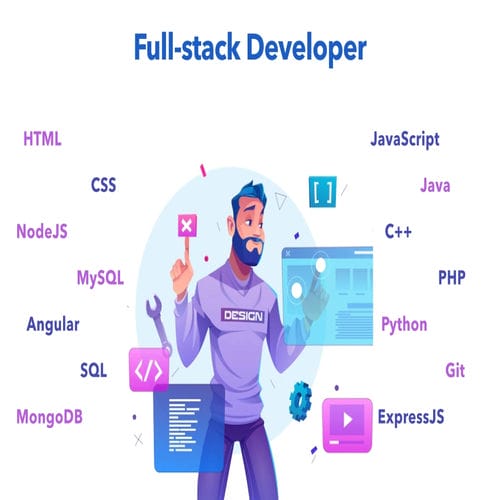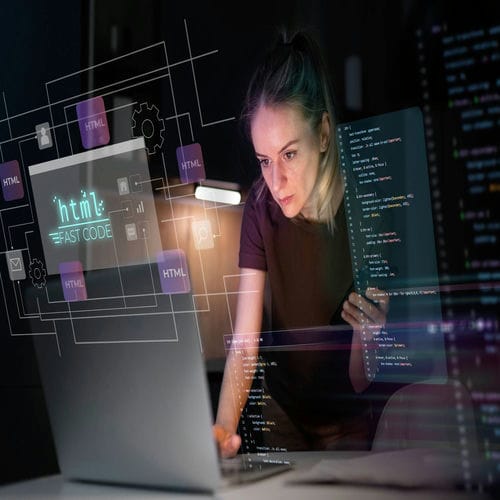Are you keen to discover how you can pursue a career as a full stack web developer while residing in Pakistan?
Aspiring to become a full stack web developer opens a gateway to endless opportunities in this digital age. Let’s embark on a journey to unveil the steps and resources needed to kick-start your career in full stack web development.
Ready to uncover the secrets behind creating immersive web experiences? Let’s dive in!
1.What is a Full Stack Developer?
A full-stack developer is defined as a professional capable of constructing both the front end and back end of a website. The front end pertains to the user-visible and interactive elements, while the back end manages data storage and processing. This role demands proficiency in diverse skill sets to effectively address both aspects of web development.
2. Front-end Module: Crafting the User Experience
Imagine visiting a website and being blown away by its seamless navigation and captivating design. That’s the magic of front-end development, and full stack developers are the masterminds behind it. Armed with HTML, CSS, and JavaScript, they sculpt the visual elements of a website, ensuring that every pixel is perfect and every interaction is vigilant.
3. Back-end Module
While front-end development focuses on what users see and interact with, back-end development powers the engine behind the scenes. Full stack developers proficient in back-end technologies like Nodes.Js, Python, or Ruby on Rails (ROR) use to build strong server-side architectures, manage databases, and handle complex business logic – all while ensuring that everything runs smoothly and securely.
4. Database Mastery
No website is complete without a reliable database to store and retrieve data. Full stack developers with database expertise design efficient data structures, write optimized queries, and ensure data integrity. Whether it’s a traditional SQL database or a modern NoSQL solution, mastering database management is crucial for building scalable and resilient web applications.
Are you curious to find out more about the complex field of full stack development? Keep reading as we unravel the skills, tools, and techniques that define this dynamic role.

The Anatomy of a Full Stack Developer
1. Frontend Mastery: Crafting User Experiences
At the forefront of every website or application lies the frontend – the part users see and interact with. Full stack developers excel in frontend development, using languages like HTML, CSS, and JavaScript to create visually appealing interfaces and seamless user experiences. From designing responsive layouts to implementing dynamic animations, they ensure that every pixel is perfect and every interaction is intuitive.
2. Backend Wizardry: Powering the Engine Behind the Scenes
Behind the scenes, full stack developers work their magic on the backend, handling the server-side operations that power make applications and webpages. This involves managing databases, implementing server logic, and ensuring that data is processed securely and efficiently. With languages like Python, Node.js, or Ruby on Rails, they build robust and scalable architectures that keep everything running smoothly.
3. Database Expertise: Where Data Meets Structure
Data is the lifeblood of any digital endeavor, and full stack developers understand the importance of effective database management. They’re proficient in database technologies like SQL and NoSQL, designing efficient data structures, writing optimized queries, and ensuring data integrity. Whether it’s storing user information, managing product catalogs, or analyzing business metrics, they know how to make data work for them.
4. Versatility Across Technologies
Full stack developers are not limited to just one technology stack – they’re comfortable working with a wide range of tools and frameworks. Whether it’s front-end frameworks like React or Angular, backend frameworks like Express.js or Django, or database technologies like MongoDB or PostgreSQL, they have the versatility to adapt to different project requirements and tech stacks.
5. Problem-Solving Skills: Navigating Challenges with Ease
In the ever-evolving world of software development, Obstacles are commonplace. Full stack developers possess strong problem-solving skills, able to diagnose issues, debug code, and find creative solutions to complex problems. Whether it’s fixing a bug in the frontend code or optimizing database performance, they approach challenges with a methodical mindset and a can-do attitude.
Understanding the multifaceted nature of full stack development is essential for anyone looking to build a career in the tech industry or embark on a digital project of their own. We’ll explore the skills and abilities that make full stack developers indispensable in today’s tech-driven world.Top of Form
Skills and Abilities of Full Stack Developers
1. Proficiency Across the Stack
Full stack developers are the Swiss Army knives of the tech world, proficient in both frontend and backend development. They’re adept at crafting elegant user interfaces using HTML, CSS, and JavaScript while also managing server-side operations with languages like Python, Node.js, or PHP. This versatility allows them to handle every aspect of a project with finesse, from the frontend presentation to the backend functionality.
2. Problem-Solving Prowess
In the dynamic world of software development, challenges are bound to arise. Full stack developers excel in problem-solving, with a knack for troubleshooting issues, debugging code, and finding innovative solutions. Whether it’s fixing a bug in the frontend interface or optimizing database queries for improved performance, they approach each problem with analytical thinking and resourcefulness.
3. Adaptability and Continuous Learning
Technology evolves at a rapid pace, and full stack developers understand the importance of staying ahead of the curve. They embrace continuous learning, staying up-to-date with new languages, frameworks, and tools to expand their skill set and stay relevant in an ever-changing industry. Whether it’s mastering a new JavaScript library or exploring emerging trends in cloud computing, they’re always eager to learn and adapt.
4. Strong Understanding of Web Development Concepts
Beyond just writing code, full stack developers possess a deep understanding of fundamental web development concepts. They’re well-versed in topics like HTTP protocols, RESTful APIs, and design patterns such as MVC (Model-View-Controller), enabling them to architect scalable and maintainable web applications. This holistic understanding enables them to formulate well-informed conclusions and create resilient solutions that endure over time.
5. Collaboration and Communication Skills
Building great software is a team effort, and full stack developers excel in collaboration. They work seamlessly with designers, frontend developers, and other stakeholders to bring projects to fruition. Their strong communication skills ensure that everyone is on the same page, ideas are shared effectively, and projects progress smoothly from concept to completion.

Advantages of Being a Full Stack Developer
1. Versatility in Project Management
Full stack developers possess the unique ability to oversee every aspect of a project, from conception to deployment. This versatility streamlines project management, as they can seamlessly transition between frontend and backend tasks, coordinate with different team members, and ensure that the project stays on track from start to finish.
2. Seamless Communication Between Teams
In a collaborative work environment, it’s critical to communicate well. Full stack developers bridge the gap between frontend and backend teams, facilitating smooth communication and collaboration across departments. Their comprehensive understanding of both sides of development allows them to translate requirements and feedback effectively, ensuring that everyone is on the same page and that projects progress smoothly.
3. Cost-Efficiency for Small to Medium-Sized Projects
For small to medium-sized projects with limited resources, hiring a full stack developer can be a cost-effective solution. Instead of hiring separate frontend and backend developers, businesses can use the expertise of a single full stack developer to handle all aspects of development. This not only reduces overhead costs but also streamlines project management and ensures a cohesive and integrated approach to development.
4. Rapid Prototyping and Iterative Development
Full stack developers excel in rapid prototyping and iterative development, allowing businesses to bring ideas to life quickly and efficiently. With their ability to handle both frontend and backend tasks, they can rapidly prototype new features, gather feedback from stakeholders, and iterate on designs in real-time. This agile approach to development enables businesses to stay nimble and responsive to changing market demands.
5. Enhanced Career Opportunities and Marketability
In today’s competitive job market, full stack developers are in high demand. Their versatile skill set and ability to handle all aspects of development make them highly sought after by employers across industries. Whether it’s working for a tech startup, a digital agency, or a large enterprise, full stack developers enjoy a wide range of career opportunities and the flexibility to pursue roles that align with their interests and expertise.
Challenges and Considerations
1. Balancing Depth and Breadth of Knowledge
One of the biggest challenges for full stack developers is balancing the depth and breadth of their knowledge. With so many technologies and frameworks to master, it can be difficult to dive deep into any one area while still maintaining proficiency across the stack. This requires careful prioritization and ongoing learning to stay up-to-date with the latest developments in both frontend and backend technologies.
2. Keeping Pace with Rapidly Evolving Technologies
The tech industry moves at lightning-fast speed, with new languages, frameworks, and tools emerging seemingly overnight. Full stack developers must constantly adapt to these changes, staying up-to-date of the latest trends and best practices to remain competitive in the job market. This requires a commitment to lifelong learning and a willingness to embrace new technologies as they emerge.
3. Potential Overwhelm Due to Vast Skillset Requirements
With so many skills to master, full stack developers can sometimes feel overwhelmed by the sheer amount of knowledge needed. From frontend languages like HTML, CSS, and JavaScript to backend technologies like Python, Node.js, and SQL, the learning curve can be steep. Managing workload and avoiding burnout becomes crucial in navigating the challenges of being a full stack developer.
4. Maintaining Currency in Both Frontend and Backend Technologies
As full stack developers balance your obligations on both the frontend and backend, it can be challenging to stay current in both areas simultaneously. While focusing on mastering one aspect of development, they risk falling behind in the other. Striking a balance between frontend and backend skills requires deliberate practice and a commitment to continuous learning.

How can I Become a Full Stack Developer?
Becoming a full stack developer is an exciting journey that offers endless opportunities for growth and innovation. Whether you’re starting from scratch or looking to transition from another field, there are various paths you can take to embark on this rewarding career. We’ll explore some key steps you can take to become a full stack developer.
1. Formal Education vs. Self-Learning Paths
One of the first decisions you’ll need to make on your journey to becoming a full stack developer is whether to pursue formal education or self-learning paths. Formal education, such as a degree in computer science or a related field, can provide you with a solid foundation in programming principles and computer science fundamentals. However, it can also be time-consuming and costly.
On the other hand, self-learning paths offer flexibility and affordability, allowing you to learn at your own pace and focus on the specific skills you need to succeed as a full stack developer. There are numerous online resources, tutorials, and courses available, covering everything from basic programming concepts to advanced web development technologies.
2. Recommended Learning Resources
If you choose to pursue a self-learning path, there are plenty of resources available to help you acquire the skills you need to become a full stack developer. Online courses, bootcamps, and books are excellent options for gaining hands-on experience and building your knowledge base.
Online courses: Platforms like Udemy, Coursera, and Codecademy offer a wide range of courses on web development, covering topics such as HTML, CSS, JavaScript, and more. These courses often include video lectures, interactive exercises, and projects to help reinforce your learning.
Bootcamps: Coding bootcamps are intensive, immersive programs designed to teach you the skills you need to become a full stack developer in a short amount of time. Bootcamps typically offer a hands-on learning experience, with instructors guiding you through real-world projects and providing personalized feedback.
Books: There are countless books available on web development and programming, covering everything from the basics of HTML and CSS to more advanced topics like database management and server-side programming. Some recommended books for aspiring full stack developers include “Eloquent JavaScript” by Marijn Haverbeke, “HTML and CSS: Design and Build Websites” by Jon Duckett, and “Node.js Design Patterns” by Mario Casciaro.
3. Building a Diverse Portfolio of Projects
One of the best ways to demonstrate your skills as a full stack developer is by building a diverse portfolio of projects. This not only showcases your technical abilities but also allows you to explore different technologies and techniques in real-world scenarios.
Start by identifying areas of interest or projects that align with your career goals. Whether it’s developing a personal blog, building an e-commerce website, or creating a web-based application, choose projects that challenge you and allow you to showcase your creativity and problem-solving skills.
As you work on these projects, document your progress, and keep track of the technologies and tools you use. Be sure to include a variety of projects that highlight different aspects of full stack development, such as frontend design, backend development, database management, and server configuration.
4. Engaging with Developer Communities and Networking
Networking is essential in any field, and the tech industry is no exception. Engaging with developer communities and networking with other professionals can provide valuable opportunities for learning, collaboration, and career advancement.
Join online forums, discussion groups, and social media communities focused on web development and full stack development. Participate in discussions, ask questions, and share your knowledge and experiences with others. This not only helps you stay updated on the latest trends and technologies but also allows you to connect with like-minded individuals who share your passion for coding.
Attend local meetups, workshops, and conferences to network with other developers and industry professionals in your area. These events provide opportunities to learn from experts, gain insights into emerging technologies, and build valuable connections that can help advance your career.
Becoming a full stack developer requires a combination of formal education, self-learning, hands-on experience, and networking. By taking advantage of the resources available to you and actively engaging with the developer community, you can acquire the skills and knowledge you need to thrive in this dynamic and rewarding field.

Conclusion
In the dynamic realm of full stack development, versatility is the name of the game. As we’ve explored, full stack developers are the architects behind the seamless web experiences we enjoy daily. From crafting captivating user interfaces to managing intricate backend operations, their expertise spans the entire development spectrum.
Embracing a career as a full stack developer opens doors to endless opportunities for innovation and growth. Whether you opt for formal education or choose self-learning paths, building a diverse portfolio and engaging with developer communities are essential steps on this journey.
Aspiring full stack developers, both seasoned and new, are poised to thrive in a field that values adaptability, creativity, and continuous learning. So, with a toolbox full of skills and a passion for problem-solving, let’s venture forth into the exciting world of full stack development, where every line of code brings us closer to digital excellence.
In closing, full stack developers are the linchpins of modern web development, seamlessly bridging the gap between frontend and backend technologies. With their diverse skill set and unwavering dedication to mastering the digital landscape, they propel the evolution of digital experiences forward.
At devtrain.co, aspiring developers can embark on their journey to mastering the art of full stack development. Join our community of learners, unlock your potential, and embark on a path filled with endless possibilities in the dynamic world of full stack development.



免费Binance账户
Your article helped me a lot, is there any more related content? Thanks!